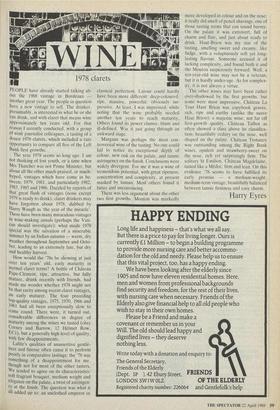1978 clarets
PEOPLE have already started talking ab- out the 1988 vintage in , Bordeaux -- another great year. The people in question have a new vintage to sell. The drinker, Presumably, is interested in what he or she can drink, and with claret that means wine approximately ten years old. For that reason I recently conducted, with a group of wing journalist colleagues, a tasting of a dozen 1978 clarets, which included a rare Opportunity to compare all five of the Left Bank first growths.
The year 1978 seems so long ago. I am not thinking of lost youth, or a time when Mrs Thatcher was not Prime Minister, but about all the other much-praised, or much- hyped, vintages which have come in be- tween; 1979, 1981, and particularly 1982, 1983, 1985 and 1986. Dazzled by reports of that great flush of vintages (none except 1979 is ready to drink), claret drinkers may have forgotten about 1978, dubbed by Harry Waugh as 'the year of the miracle'. There have been many miraculous vintages In wine-making annals (perhaps the Vati- can should investigate): what made 1978 Special was the salvation of a miserable summer by an Indian autumn warm, dry weather throughout September and Octo- ber, leading to an extremely late, but dry and healthy harvest.
How would the '78s be showing at just over ten years' old, early maturity in normal claret terms? A bottle of Château Pape-Clement, ripe, attractive, but fully mature, drunk recently with friends, had made me wonder whether 1978 might not be that rarity among recent claret vintages, an early maturer. The four preceding top-quality vintages, 1975, 1970, 1966 and 1961 had all been exceptionally slow to come round. There were, it turned out, considerable differences in degree of maturity among the wines we tasted (chez Carney and Barrow, 12 Helmet Row, Ed), but a generally high level of quality, With few disappointments.
Lafite's qualities of unassertive gentle- ness and finesse often cause it to perform Poorly in comparative tastings: the '78 was something of a disappointment for me, though not for most of the other tasters. We tended to agree on its characteristics: soft fragrant bouquet, medium weight and elegance on the palate, a twist of astringen- cy at the finish. The question was what it all added up to: an unclothed emperor or classical perfection. Latour could hardly have been more different: deep-coloured, ripe, massive, powerful, obviously im- pressive. At least, I was impressed, while noting that the wine probably needed another ten years to reach maturity. Others found its power clumsy, blunt and ill-defined. Was it just going through an awkward stage.
Margaux was perhaps the most con- troversial wine of the tasting. No one could fail to notice its exceptional depth of colour, new oak on the palate, and tannic astringency on the finish. Conclusions were widely divergent. For me it was .a wine of tremendous potential, with great ripeness, concentration and complexity, at present masked by tannin. Most others found it bitter and unconvincing.
There was less argument about the other two first growths. Mouton was markedly more developed in colour and on the nose: it really did smell of pencil shavings, one of those tasting terms that can sound barmy. On the palate it was extrovert, full of charm and flair, and just about ready to drink. Haut-Brion was my star of the tasting, smelling sweet and creamy, like fudge, with a voluptuously soft yet long- lasting flavour. Someone accused it of lacking complexity, and found both it and the Mouton suspiciously forward. Well, a ten-year-old wine may not be a veteran, but it is hardly under-age. As for complex- ity, it is not always a virtue.
The other wines may have been rather over-shadowed by the first growths, but some were most impressive. Château La Tour Haut Brion was copybook graves, rich, ripe and earthy (unlike the suave Haut Brion): a majestic wine, not far off first-growth quality. Château Talbot as often showed a class above its classifica- tion: beautifully cedary on the nose, well shaped on the palate. Chateau Trotanoy was outstanding among the Right Bank wines, opulent and strawberry-sweet on the nose, rich yet surprisingly firm. The solitary St Emilion, Château Magdelaine, tasted like a Medoc, firm and lean. On this evidence '78 seems to have fulfilled its early promise — a medium-weight, medium-term vintage, beautifully balanced between tannic firmness and easy charm.
Harry Eyres


































































 Previous page
Previous page